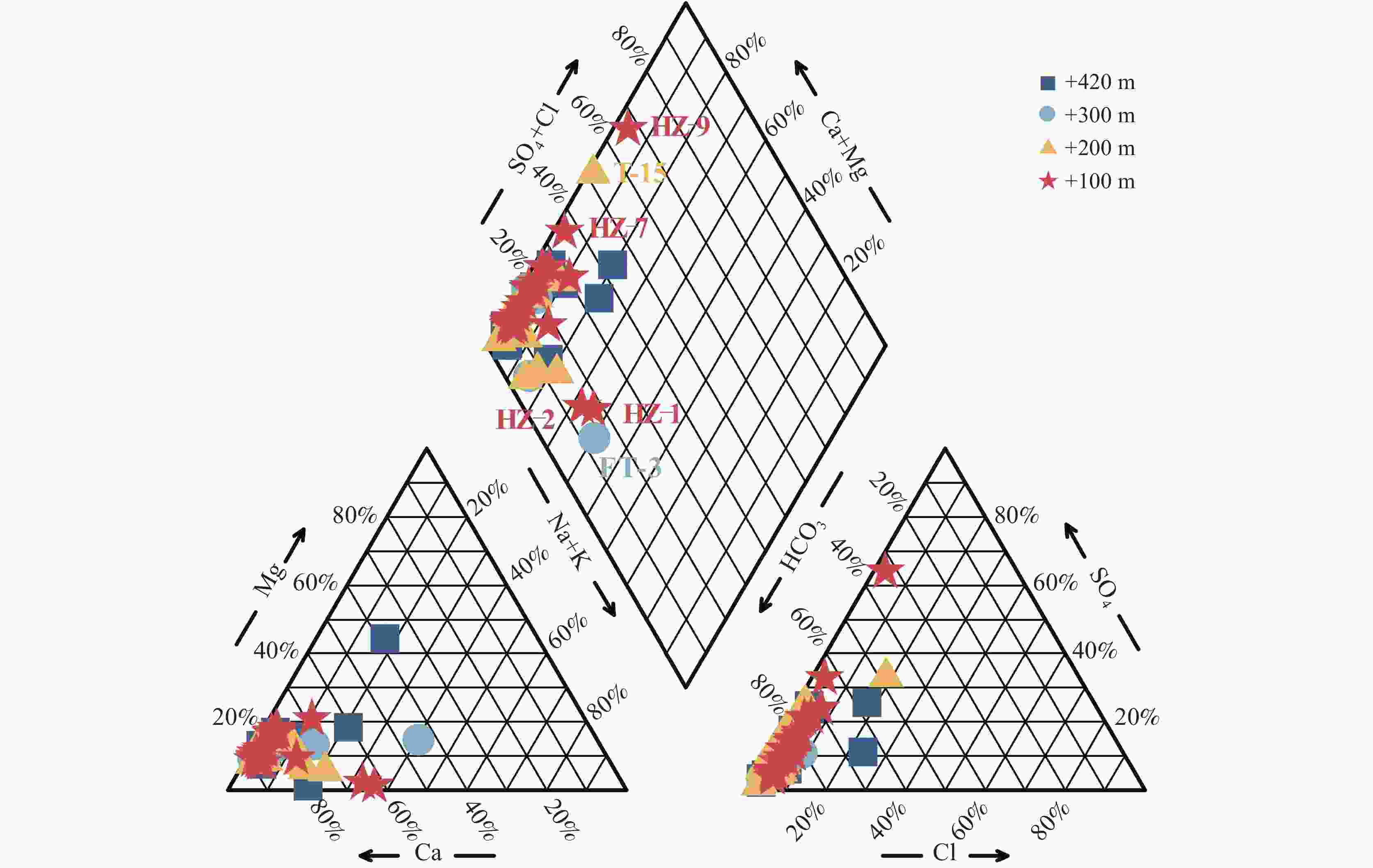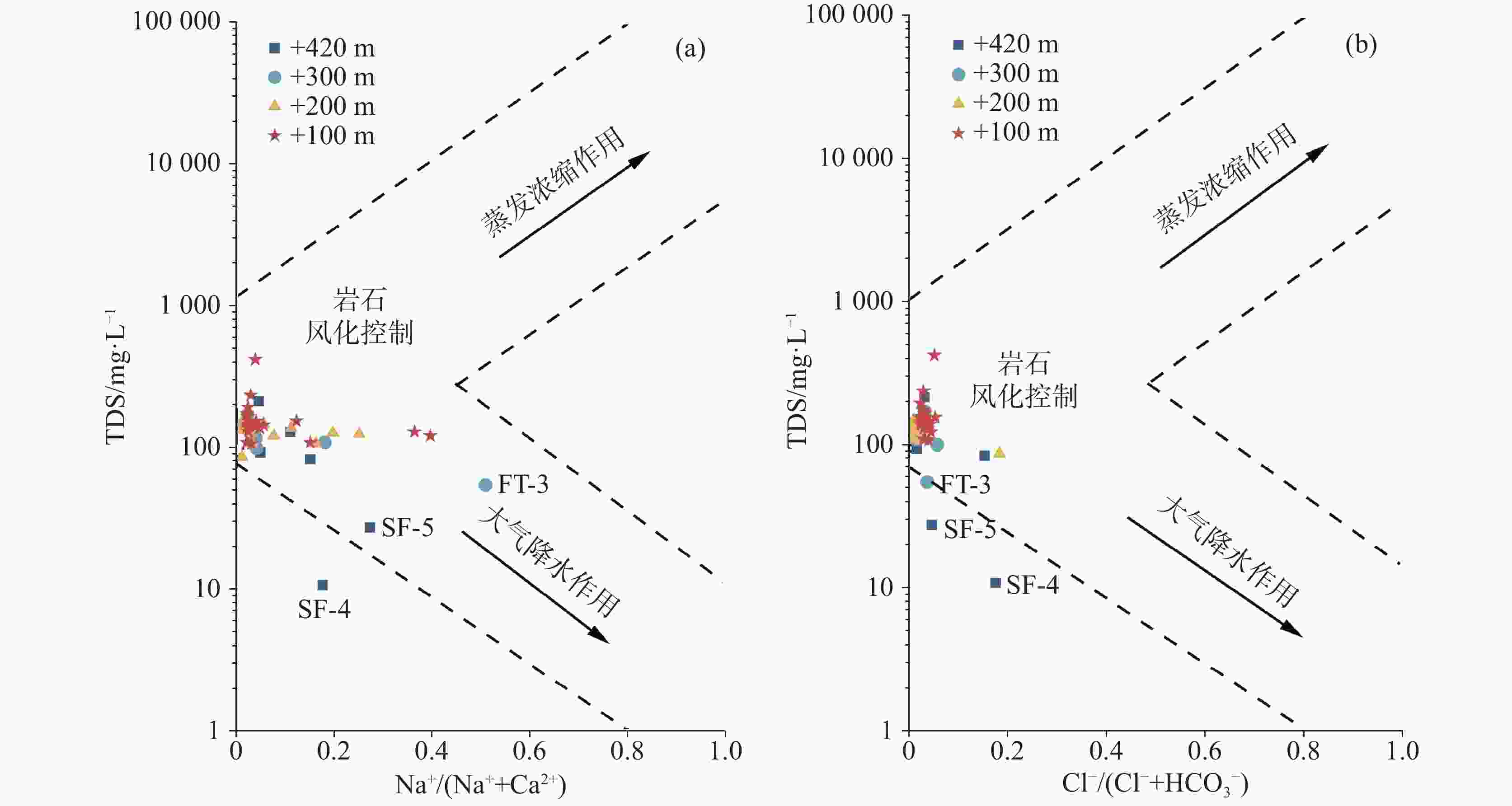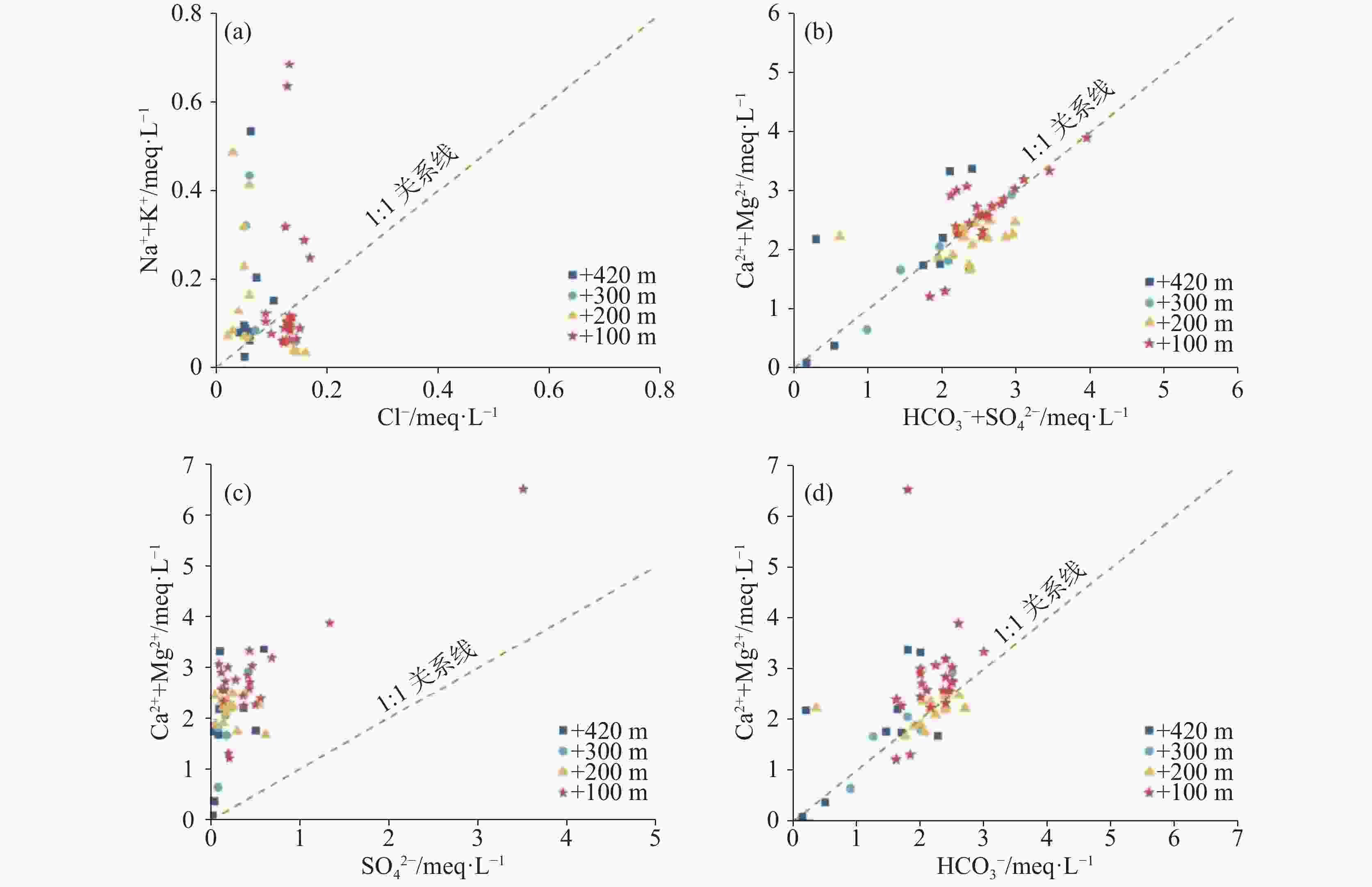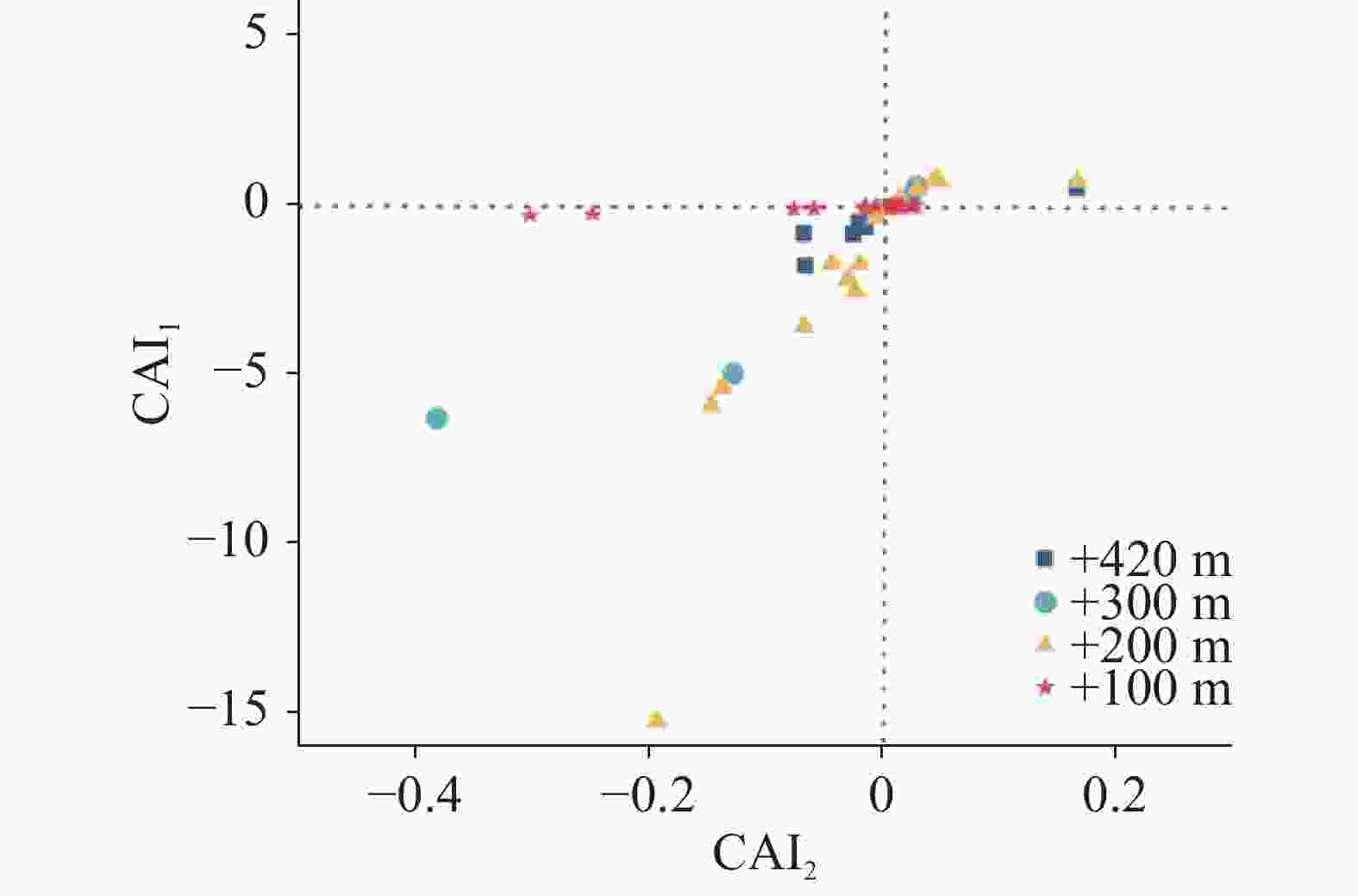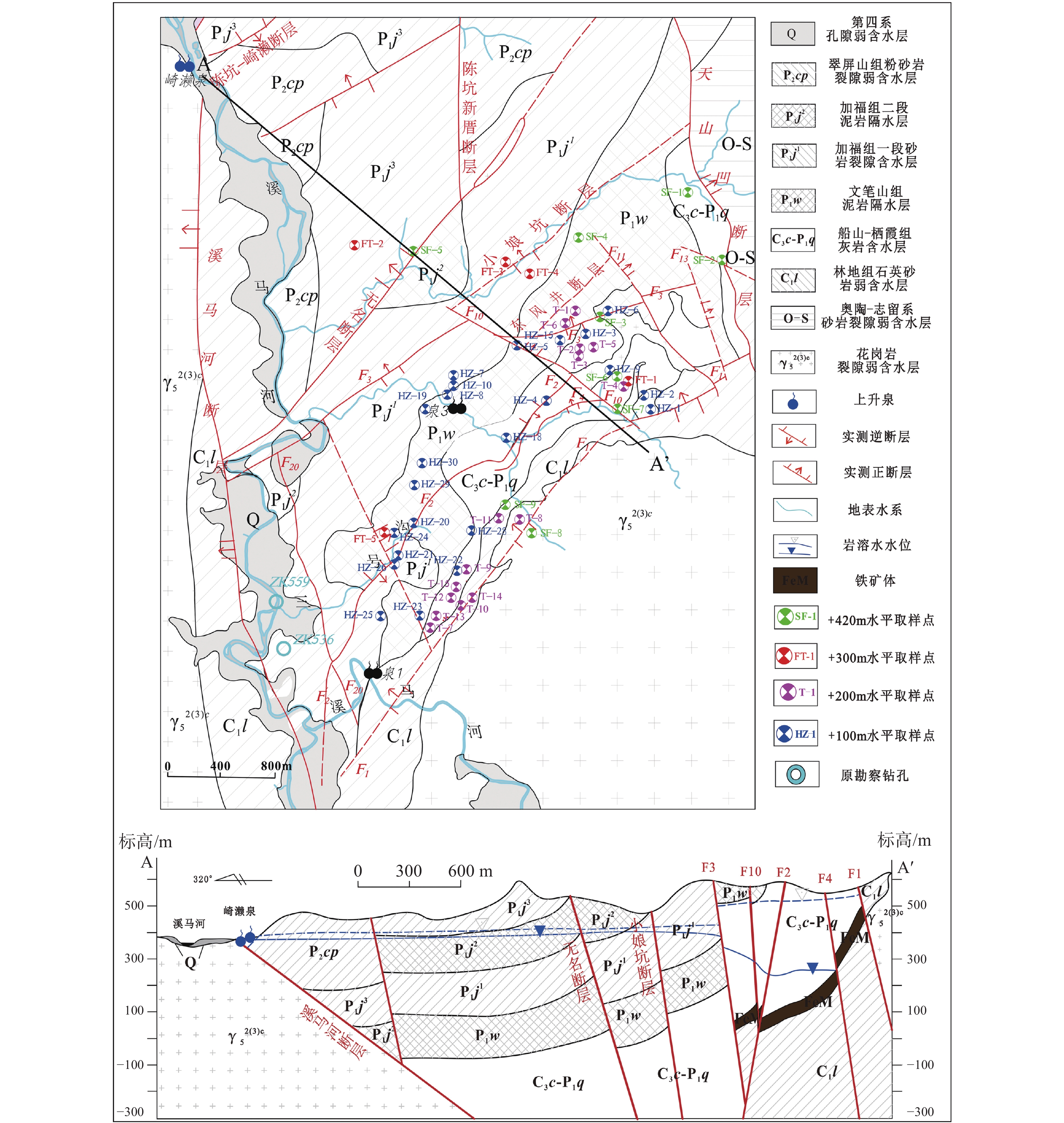Study on hydrochemical characteristics and water inflow sources of typical karst water-filled mining areas under the influence of extended mining
-
摘要: 为探究延深开采影响下典型岩溶充水矿区水化学成因及涌水水源变化过程,选取马坑矿区+420 m、+300 m、+200 m、+100 m四个开采水平涌水点为研究对象,在分析矿区地下水流系统演变规律的基础上,综合运用Piper三线图、离子组合比、Gibbs图、氯碱指数等水化学方法并概化涌水点水源演化概念模型,对矿区不同开采水平涌水点水化学成因及补给来源进行了讨论。结果表明:向深部开采过程中,矿区地下水径流方向发生变化,水温、pH及TDS随开采深度不断增大,水化学类型则由HCO3-Ca型逐渐向HCO3·SO4-Ca型和HCO3-Na·Ca型演变。矿区地下水化学组分主要受碳酸岩盐溶解作用影响,其次不同开采水平还伴随黄铁矿氧化、阳离子交换作用、混合作用等因素的影响;+420 m及+300 m水平涌水点充水水源为岩溶水、P1j1砂岩水混合水源,而+200 m与+100 m开采水平主要充水水源为岩溶水且深部花岗岩低温热水沿导水断层对+100 m水平涌水点进行补给。研究结果可为同类型岩溶充水矿区地下水管理及矿坑水防治提供一定参考。Abstract:
Mineral resources are an important pillar of China's vigorous economic development. With the rapid increase in the demand for metal minerals, the original metal mining areas continue to be mined. However, the specific geological conditions indicate that a significant number of ore bodies in China are closely associated with the limestone strata. As a result, the karst aquifer has emerged as one of the major hidden dangers threatening the deep mining of these ore deposits. Therefore, it is an important topic to study the prevention and control of pit water in mines of karst areas, but there is a lack of comprehensive case studies that have revealed the changes in water sources in pits due to deep mining on the basis of hydrochemical data from water inflow points at different mining levels. The Makeng mining area is a typical karst water-filled mining area in East China. Its hydrogeological conditions and pit water-filling conditions are complex, presenting significant challenges for water prevention and control efforts. In this study, 59 sets of hydrochemical data were selected from the water inflow points of horizontal tunnels at four mining levels (+420 m, +300 m, +200 m and +100 m) in the Makeng mining area from 2006 to 2016. Combined with the evolution law of the groundwater flow system in the mining area, various hydrochemical methods such as Piper three-line diagram, ion ratio, Gibbs diagram and chlor-alkali index were used to analyze the source of water inflow. The mixing ratios of different water sources were calculated, and a conceptual model of evolution of water sources at the water inflow points was generalized. Besides, the hydrochemical causes and recharge sources of water inflow points at different mining levels in the mining area were discussed. The results show that the decrease of groundwater levels gradually slowed down while and water inflow continuously increased during the mining process; therefore the recharge sources of pit water inflow points constantly changed. Secondly, the long-term water drainage and depressurization changed the direction of groundwater runoff in the mining area. Additionally, the water temperature, pH and TDS increased with the increase of mining depth, and the hydrochemical type gradually changed from HCO3-Ca type to HCO3·SO4-Ca type and HCO3-Na·Ca type. The dissolution of carbonate salt is the main controlling factor for the formation of groundwater in the mining area. Besides, controlled by faults and other geological structures, some water inflow points were influenced by different water sources in some degree. Moreover, different mining levels were also affected by pyrite oxidation, cation exchange, mixing action, etc. The sources of water inflow points at +420 m and +300 m were from karst water and P1j1 sandstone water, while the main sources at mining levels of +200 m and +100 m were also from karst water. The water inflow point at +100 m was recharged by low-temperature hot water along the water diversion fault from deep granite. The Ca2+ and Cl− equilibrium models were used to calculate the respective ratios of mixing karst water with sandstone fracture water and of mixing karst water with hot water from deep granite. The recharge rates of fracture water at +420 m and +300 m were about 22.7%–82.8%, and the recharge rates of low-temperature hot water from deep granite at +100 m were 35.1%–38.3%. In the future, the monitoring of water quality in water inflow points at +100 m or above should be strengthened. If necessary, F1 and other faults exposed underground should be grouted so as to prevent the low-temperature hot water from the contact zone between the deep granite and the quartz sandstone of Lindi formation (C1l) from entering the pit along the water diversion structure to recharge karst water. In this paper, the hydrochemical formation of water inflow source in Makeng mining area under the influence of extended mining has been discussed, and the dynamic characteristics of water inflow sources have been preliminarily analyzed, which can provide a certain reference for groundwater management and prevention and control of pit water in the same type of karst water-filled mining area. -
Key words:
- extended mining /
- karst water-filled mining area /
- mining level /
- hydrochemistry /
- water inflow sources
-
表 1 研究区地下水主要水化学指标统计表
Table 1. Statistics of main hydrochemical indicators of groundwater in the study area
开采水平 项目 pH TDS 水温 Ca2+ Mg2+ Na+ K+ ${\rm{HCO}}_3^{-}$ ${\rm{SO}}_4^{2-}$ Cl− +420 m
(n=9)平均值 6.63 105.73 20.37 32.21 2.95 2.29 1.82 79.46 9.81 2.20 标准差 0.99 58.36 1.89 19.13 1.81 2.11 2.19 46.37 10.06 0.61 Cv(%) 14.89 55.20 9.26 59.41 61.30 92.28 120.17 58.36 102.50 27.50 +300 m
(n=5)平均值 7.22 109.15 20.46 30.40 2.87 4.79 0.78 101.60 9.02 3.45 标准差 0.44 37.33 1.75 13.84 0.68 3.61 0.64 34.23 6.07 1.35 Cv(%) 6.05 34.20 8.57 45.52 23.82 75.45 82.13 33.69 67.30 39.00 +200 m
(n=15)平均值 7.31 128.82 21.22 38.42 2.91 3.05 0.79 128.47 11.13 2.74 标准差 0.28 16.99 0.48 4.53 0.84 3.27 0.59 32.27 7.66 1.68 Cv(%) 3.82 13.19 2.24 11.80 28.79 107.12 74.01 25.12 68.81 61.32 +100 m
(n=22)平均值 7.65 159.24 23.19 48.97 4.26 3.24 0.89 134.40 23.58 4.58 标准差 0.30 62.29 1.91 16.75 2.18 3.90 0.64 20.98 33.35 0.65 Cv(%) 3.90 39.12 8.22 34.20 51.10 120.45 72.50 15.61 141.45 14.12 注:pH、Cv为无量纲;水温单位为 ℃,其余单位均为mg·L−1。
Note: pH and Cv are dimensionless; the unit of water temperature is ℃; the other units are symbolized by mg·L−1.表 2 矿区水化学背景值
Table 2. Hydrochemical background values of the mining area
地下水类型 Na+K Ca2+ Mg2+ Cl− ${\rm{SO}}_4^{2-}$ ${\rm{HCO}}_3^{-}$ 岩溶水背景值 1.79 46.12 2.97 2.94 9.33 148.89 砂岩裂隙水背景值 1.20 2.06 1.48 1.83 1.02 12.15 花岗岩裂隙水背景值 2.48 1.29 0.13 2.23 1.26 3.80 HZ-9岩溶水 6.48 114.60 9.58 6.01 168.24 109.84 注:以上指标单位均为mg·L−1。
Note: The units of above indicators are all mg·L−1.表 3 矿区涌水点水源混合比
Table 3. Mixing ratios of water sources at water inflow points in the mining area
开采水平 编号 混合比率/% 岩溶水 砂岩裂隙水 深部花岗岩裂隙水 +420 m
水平SF-1 77.3 22.7 / SF-2 62.6 37.4 / SF-7 65.3 34.7 / SF-9 60.9 39.1 / +300 m
水平FT-1 73.5 26.5 / FT-2 64.2 35.8 / FT-3 17.2 82.8 / FT-4 60.4 39.6 / +100 m
水平HZ-1 64.9 / 35.1 HZ-2 61.7 / 38.3 -
[1] 陈彦美. 南方岩溶金属矿区地下水防治理论与实践:以福建马坑铁矿为例[D]. 武汉:中国地质大学(武汉), 2013.CHEN Yanmei. Theory and practice of karst water control and prevention in iron mining area, in South China: A case study of Makeng iron mining, Fujian Province[D]. Wuhan: China University of Geosciences (Wuhan), 2013. [2] 黄荷, 陈植华, 王涛, 罗朝晖, 张亮, 王剑, 项彩娟, 孙帮涛, 王勇. 岩溶矿区水文地球化学特征及其水源指示意义[J]. 水文地质工程地质, 2019, 46(1):19-26.HUANG He, CHEN Zhihua, WANG Tao, LUO Zhaohui, ZHANG Liang, WANG Jian, XIANG Caijuan, SUN Bangtao, WANG Yong. Groundwater source identification in carbonate-hosted deposit using hydrogeochemistry, hydrogen and oxygen isotope method[J]. Hydrogeolog & Engineering Geology, 2019, 46(1): 19-26. [3] 陈彦美, 陈植华, 康彩琴. 从马坑铁矿看我国南方岩溶金属矿山防治水工作[J]. 金属矿山, 2012(2):18-113, 152. doi: 10.3969/j.issn.1001-1250.2012.02.031CHEN Yanmei, CHEN Zhihua, KANG Caiqin. Views on metal mine water prevention and control in South China from Makeng iron mine[J]. Metal Mine, 2012(2): 18-113, 152. doi: 10.3969/j.issn.1001-1250.2012.02.031 [4] 袁道先, 蒋勇军, 沈立成, 蒲俊兵, 肖琼, 等. 现代岩溶学[M]. 北京:科学出版社, 2016. [5] Qiao X J, Li G M, Li M, Zhou J L, Du J, Du C Y, Sun Z H. Influence of coal mining on regional karst groundwater system: A case study in West mountain area of Taiyuan City, Northern China[J]. Environmental Earth Sciences, 2011, 64: 1525-1535. doi: 10.1007/s12665-010-0586-3 [6] Zhang H, Wang Y, Yang R X, Ye R Z. Modeling the effects of phosphate mining on groundwater at different stages of mine development[J]. Mine Water and the Environment, 2018, 37(3): 604-616. doi: 10.1007/s10230-018-0510-8 [7] Yang Y G, Guo T T, Jiao W T. Destruction processes of mining on water environment in the mining area combining isotopic and hydrochemical tracer[J]. Environmental Pollution, 2018, 237: 356-365. doi: 10.1016/j.envpol.2018.02.002 [8] Motyka J, Postawa A. Impact of Zn−Pb mining in the Olkusz ore district on the Permian aquifer (SW Poland)[J]. Environmental Science and Pollution Research, 2013, 20: 7582-7589. doi: 10.1007/s11356-013-1740-8 [9] Huang H, Chen Z H, Wang T, Zhang L, Zhou G M, Sun B T, Wang Y. Characteristics and processes of hydrogeochemical evolution induced by long-term mining activities in karst aquifers, Southwestern China[J]. Environmental Science and Pollution Research International, 2019, 26(29): 30055-30068. [10] Huang H, Chen Z H, Wang T, Xiang C J, Zhang L, Zhou G M, Sun B T, Wang Y. Nitrate distribution and dynamics as indicators to characterize karst groundwater flow in a mined mineral deposit in Southwestern China[J]. Hydrogeology Journal, 2019, 27(6): 2077-2089. doi: 10.1007/s10040-019-01987-0 [11] 吴晓丽, 张杨, 孙媛媛, 吴吉春. 平朔矿区地下水水化学特征及成因[J]. 南京大学学报(自然科学版), 2021, 57(3):417-425.WU Xiaoli, ZHANG Yang, SUN Yuanyuan, WU Jichun. Hydrochemical characteristics and formation mechanism of groundwater in Pingshuo mining area[J]. Journal of Nanjing University (Natural Science), 2021, 57(3): 417-425. [12] 周智强, 黄奇波, 汪玉松, 罗飞, 梁建宏, 熊江俣. 典型岩溶矿区地表水和地下水补给来源及水化学演化机制[J]. 环境科学, 2024, 45(9):5264-5276ZHOU Zhiqiang, HUANG Qibo, WANG Yusong, LUO Fei, LIANG Jianhong, XIONG Jiangyu. Recharge sources and hydrochemical evolution mechanism of surface water and groundwater in typical karst mining area[J]. Environmental Science, 2024, 45(9): 5264-5276. [13] 陈亚洲, 任虎俊, 李曦滨, 李健, 王锋利. 大同煤田寒武—奥陶系岩溶水系统东北区特征分析[J]. 中国岩溶, 2019, 38(6):876-882. doi: 10.11932/karst2019y04CHEN Yazhou, REN Hujun, LI Xibin, LI Jian, WANG Fengli. Characteristics of the Cambrian−Ordovician karst water system in the northeastern Datong coalfield[J]. Carsologica Sinica, 2019, 38(6): 876-882. doi: 10.11932/karst2019y04 [14] 陈彦美, 陈植华, 於开炳. 地下水水位及水温在查明矿区岩溶水补给条件中的应用:以福建马坑铁矿为例[J]. 中国岩溶, 2013, 32(1):64-72. doi: 10.3969/j.issn.1001-4810.2013.01.010CHEN Yanmei, CHEN Zhihua, YU Kaibing. To identify the recharge conditions of karst groundwater in mining area by means of groundwater table and water temperature data: A case in Makeng iron mine, Fujian[J]. Carsologica Sinica, 2013, 32(1): 64-72. doi: 10.3969/j.issn.1001-4810.2013.01.010 [15] 杜欣, 陈植华, 林荣荣, 秦松柏. 福建马坑矿区水化学微量组分的指示作用[J]. 水文地质工程地质, 2008, 35(6):33-37.DU Xin, CHEN Zhihua, LIN Rongrong, QIN Songbai. Hydrogeochemistry of trace elements in groundwater from Makeng district, Fujian Province[J]. Hydrogeolog & Engineering Geology, 2008, 35(6): 33-37. [16] 赖树钦. 微量元素在福建马坑铁矿崎濑泉形成条件识别中的应用[J]. 中国岩溶, 2008, 27(4):347-351, 358.LAI Shuqin. Identification to formation condition by means of trace elements: A case in Qilai spring, Makeng iron mine, Fujian Province[J]. Carsologica Sinica, 2008, 27(4): 347-351, 358. [17] 李贵仁, 赵珍, 陈植华. 复杂岩溶矿区疏干条件下的地下水数值模拟:以福建省马坑铁矿为例[J]. 中国岩溶, 2012, 31(4):382-387.LI Guiren, ZHAO Zhen, CHEN Zhihua. Numerical simulation for groundwater under draining condition in complex karst mining area: An example from the Makeng iron mine in Fujian Province[J]. Carsologica Sinica, 2012, 31(4): 382-387. [18] 陈彦美, 陈植华, 於开炳. 南方岩溶金属矿区地下水非均质性及防治水意义:以福建马坑铁矿为例[J]. 地球科学, 2016, 41(4):692-700.CHEN Yanmei, CHEN Zhihua, YU Kaibing. Heterogeneity and water prevention of karst water system in metal mine areas in Southern China: A case study of Makeng iron mine, Fujian Province[J]. Earth Science, 2016, 41(4): 692-700. [19] 黄奇波. 北方半干旱岩溶区岩溶碳汇过程及效应研究:以山西柳林泉岩溶流域为例[D]. 武汉:中国地质大学(武汉), 2019.HUANG Qibo. The carbon sequestration effect in semi-arid karst area: A case study of Liuling spring catchment, Shanxi Province[D]. Wuhan: China University of Geosciences (Wuhan), 2013. [20] 卢丽, 陈余道, 邹胜章, 樊连杰, 林永生, 王喆. 岩溶区典型工业型城市地下水水化学特征及成因机制[J]. 中国岩溶, 2022, 41(4):588-598.LU Li, CHEN Yudao, ZOU Shengzhang, FAN Lianjie, LIN Yongsheng, WANG Zhe. Hydrochemical characteristics and water quality evaluation of karst groundwater in typical industrial cities[J]. Carsologica Sinica, 2022, 41(4): 588-598. [21] 陈浩, 王家鼎, 王琳琳, 杨传伟, 姜福红. 山东省邹城市东部地下水水化学特征及形成机制[J]. 中国岩溶, 2023, 42(1):139-148.CHEN Hao, WANG Jiading, WANG Linlin, YANG Chuanwei, JIANG Fuhong. Hydrochemical characteristics and formation on mechanism of groundwater in east Zoucheng City, Shandong Province[J]. Carsologica Sinica, 2023, 42(1): 139-148. [22] Zhang C C, Li X Q, Wang Z X, Hou X W, Ma J F, Gao M, Bai Z X, Fu C C, Gui C L, Zuo X F. Combining stable isotope (2H, 18O, and 87Sr/86Sr) and hydrochemistry to understand hydrogeochemical processes in karst groundwater system, Xin'an, Northern China[J]. Environmental Earth Sciences, 2023, 82(9): 224. doi: 10.1007/s12665-023-10906-2 [23] Gibbs R J. Mechanisms controlling world water chemistry[J]. Science, 1970, 170(3962): 1088-1090. doi: 10.1126/science.170.3962.1088 [24] 蒲俊兵, 袁道先, 蒋勇军, 苟鹏飞, 殷建军. 重庆岩溶地下河水文地球化学特征及环境意义[J]. 水科学进展, 2010, 21(5):628-636.PU Junbing, YUAN Daoxian, JIANG Yongjun, GOU Pengfei, YIN Jianjun. Hydrogeochemistry and environmental meaning of Chongqing subterranean karst stream in China[J]. Advances in Water Science, 2010, 21(5): 628-636. [25] 李伟, 耿函, 苏春利, 曹慧丽, 梁川, 卫方成. 大冶铁矿区地下水水化学演化过程及铁和硫酸盐污染机制[J]. 安全与环境工程, 2023, 30(2):223-232.LI Wei, GENG Han, SU Chunli, CAO Huili, LIANG Chuan, WEI Fangcheng. Hydrochemical evolution processes and mechanism of groundwater iron and sulfate pollution in Daye mining area[J]. Safety and Environmental Engineering, 2023, 30(2): 223-232. [26] Zhang X B, Li X, Gao X B. Hydrochemistry and coal mining activity induced karst water quality degradation in the Niangziguan karst water system, China[J]. Environmental Science and Pollution Research International, 2015, 23(7): 6286-6299. [27] 熊亮萍, 胡圣标, 汪缉安, 汪集旸. 福建省西部大地热流值[J]. 地质科学, 1993, 28(1):96-101.XIONG Liangping, HU Shengbiao, WANG Ji'an, WANG Jiyang. Terrestrial heat flow in western part of Fujian Province, SE China[J]. Chinese Journal of Geology, 1993, 28(1): 96-101. [28] 黄望望. 新集矿区地下水水文地球化学与环境同位素特征[D]. 合肥:安徽大学, 2020.HUANG Wangwang. Groundwater hydrogeochemistry and environmental isotope characteristics in Xinji mining area[D]. Hefei: Anhui University, 2020. [29] 王甜甜, 张雁, 赵伟, 靳德武, 刘基, 王强民. 伊敏矿区地下水水化学特征及其形成作用分析[J]. 环境化学, 2021, 40(5):1480-1489.WANG Tiantian, ZHANG Yan, ZHAO Wei, JIN Dewu, LIU Ji, WANG Qiangmin. Hydrogeochemical characteristics and formation process of groundwater in Yimin mining area[J]. Environmental Chemistry, 2021, 40(5): 1480-1489. [30] 冯海波, 董少刚, 张涛, 李铱, 刘晓波, 李政葵, 王超. 典型草原露天煤矿区地下水环境演化机理研究[J]. 水文地质工程地质, 2019, 46(1):163-172.FENG Haibo, DONG Shaogang, ZHANG Tao, LI Yi, LIU Xiaobo, LI Zhengkui, WANG Chao. Evolution mechanism of a groundwater system in the opencast coalmine area in the typical prairie[J]. Hydrogeolog & Engineering Geology, 2019, 46(1): 163-172. [31] 唐辉, 陈洁, 钱会. 饱和指数在水—岩作用研究中的应用及其灵敏度分析[J]. 水资源与水工程学报, 2012, 23(6):180-183.TANG Hui, CHEN Jie, QIAN Hui. Application of saturation index to research of water–rock interaction and its sensitivity analysis[J]. Journal of Water Resources & Water Engineering, 2012, 23(6): 180-183. [32] 黄奇波, 覃小群, 刘朋雨, 程瑞瑞, 李腾芳. 柳林泉域岩溶地下水区域演化规律及控制因素[J]. 环境科学, 2019, 40(5):2132-2142.HUANG Qibo, QIN Xiaoqun, LIU Pengyu, CHENG Ruirui, LI Tengfang. Regional evolution and control factors of karst groundwater in Liulin spring catchment[J]. Environmental Science, 2019, 40(5): 2132-2142. [33] 黄奇波, 覃小群, 刘朋雨, 张连凯, 苏春田. 人为活动对乌江中上游段岩溶地下水δ13CDIC及碳汇效应的影响[J]. 第四纪研究, 2016, 36(6):1358-1369.HUANG Qibo, QIN Xiaoqun, LIU Pengyu, ZHANG Liankai, SU Chuntian. The impact of human activities to δ13CDIC of karst groundwater and carbon sink in the upper and middle reaches of Wujiang river[J]. Quaternary Science, 2016, 36(6): 1358-1369. [34] Han D M, Liang X, Jin M G, Currell M J, Song X F, Liu C M. Evaluation of groundwater hydrochemical characteristics and mixing behavior in the Daying and Qicun geothermal systems, Xinzhou basin[J]. Journal of Volcanology and Geothermal Research, 2010, 189(1-2): 92-104. doi: 10.1016/j.jvolgeores.2009.10.011 [35] 张慧, 郑金龙. 福建马坑铁矿主要含水层水化学特征与突水水源的识别[J]. 有色金属(矿山部分), 2010, 62(2):20-24, 30.ZHANG Hui, ZHENG Jinlong. Recognition of hydrochemical characteristics and water dource in Makeng iron mine, Fujian Province[J]. Nonferrous Metals (Mining Section), 2010, 62(2): 20-24, 30. -





 下载:
下载:
